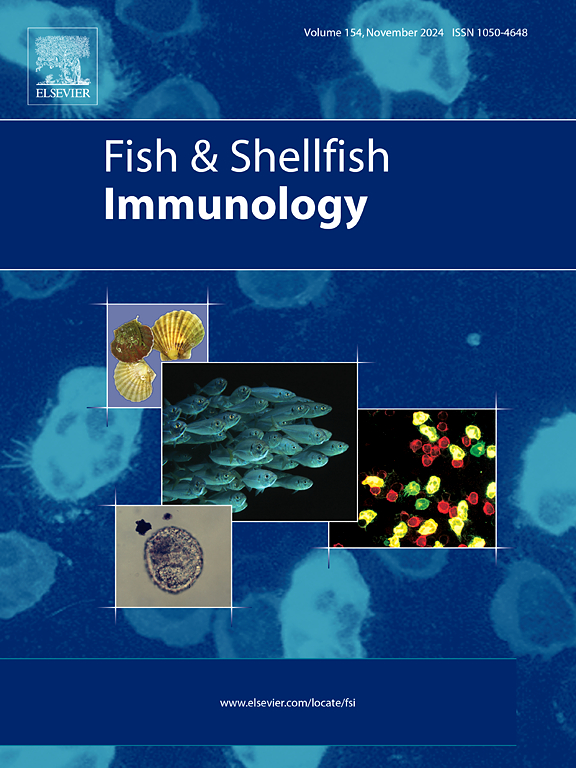Evolution and expression of TLR5a and TLR5b in lamprey (Lampetra japonica)
IF 4.1
2区 农林科学
Q1 FISHERIES
引用次数: 0
Abstract
The lamprey serves as a key model organism for studying the origin and evolution of species, embryonic development, and the immune system. The immune system primarily relies on pattern recognition receptors, including Toll-like receptors (TLRs), with Toll-like receptor 5 (TLR5) having a particularly complex evolutionary history. Currently, although TLR5 is being identified in an expanding array of taxonomic groups, a comprehensive study on its evolutionary aspects is yet to be conducted. In this study, we identified Lj-TLR5a and Lj-TLR5b in Lampetra japonica and examined their distribution across various tissues in this species. Furthermore, we conducted preliminary investigations into their immune functions and discovered that, as primitive genes, they are highly sensitive to various pathogens. Upon recognizing flagellar proteins, both Lj-TLR5a and Lj-TLR5b work together; however, these TLRs may function independently in response to other stimuli. Subsequently, we performed comprehensive structural and evolutionary analyses of the TLR5 family, incorporating TLR5 data from various species at different evolutionary stages. Our findings revealed that TLR5a and TLR5b in lamprey are in a relatively primitive evolutionary state. Meanwhile, TLR5L differentiated during the early stages of evolution and exhibits a pseudogenic trend throughout this evolutionary process; notably, this TLR is currently preserved only in certain amphibian and reptile species. In cartilaginous fish, only one type of TLR5 is usually retained, whereas bony fish typically possess both TLR5 and TLR5S. TLR5S has a relatively simple structure, likely arising from repetitive whole-genome events in bony fishes. Among bony fishes, flesh-finned fish were found to retain only one TLR5, which eventually evolved into the TLR5 found in quadrupeds. In summary, this study provides significant insights into the origin and evolution of the TLR5 family by analyzing the evolutionary status and immune functions of Lj-TLR5a and Lj-TLR5b in Japanese lampreys.
TLR5a和TLR5b在七鳃鳗中的进化与表达。
七鳃鳗是研究物种起源和进化、胚胎发育和免疫系统的关键模式生物。免疫系统主要依赖于模式识别受体,包括toll样受体(TLRs),其中toll样受体5 (TLR5)具有特别复杂的进化史。目前,虽然在越来越多的分类群中发现了TLR5,但对其进化方面的全面研究尚未开展。本研究在日本七鳃鳗中鉴定出Lj-TLR5a和Lj-TLR5b,并研究了它们在该物种各组织中的分布。此外,我们对其免疫功能进行了初步调查,发现作为原始基因,它们对各种病原体高度敏感。在识别鞭毛蛋白时,Lj-TLR5a和Lj-TLR5b协同工作;然而,这些tlr可能在对其他刺激的反应中独立起作用。随后,我们对TLR5家族进行了全面的结构和进化分析,纳入了不同物种在不同进化阶段的TLR5数据。结果表明,TLR5a和TLR5b在七鳃鳗中处于相对原始的进化状态。与此同时,TLR5L在进化早期就已分化,并在整个进化过程中呈现假基因倾向;值得注意的是,这种TLR目前只保存在某些两栖动物和爬行动物物种中。在软骨鱼中,通常只保留一种TLR5,而硬骨鱼通常同时拥有TLR5和TLR5S。TLR5S结构相对简单,可能源于硬骨鱼类重复的全基因组事件。在硬骨鱼类中,肉鳍鱼被发现只保留了一个TLR5,最终进化成四足动物的TLR5。综上所述,本研究通过分析Lj-TLR5a和Lj-TLR5b在日本七鳃鳗中的进化状态和免疫功能,对TLR5家族的起源和进化有重要意义。
本文章由计算机程序翻译,如有差异,请以英文原文为准。
求助全文
约1分钟内获得全文
求助全文
来源期刊

Fish & shellfish immunology
农林科学-海洋与淡水生物学
CiteScore
7.50
自引率
19.10%
发文量
750
审稿时长
68 days
期刊介绍:
Fish and Shellfish Immunology rapidly publishes high-quality, peer-refereed contributions in the expanding fields of fish and shellfish immunology. It presents studies on the basic mechanisms of both the specific and non-specific defense systems, the cells, tissues, and humoral factors involved, their dependence on environmental and intrinsic factors, response to pathogens, response to vaccination, and applied studies on the development of specific vaccines for use in the aquaculture industry.
 求助内容:
求助内容: 应助结果提醒方式:
应助结果提醒方式:


